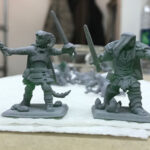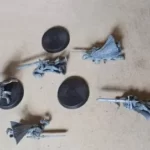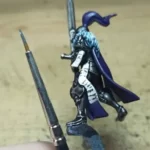Miniature types – painting metal vs. plastic vs. resin

One of the reasons why getting a miniature kit is difficult is the type of material. Today, most companies are switching from producing plastic miniatures to resin, while most have abandoned the idea of making those with metal materials.
Of course, as long as the miniatures are good quality, it would be easy to paint metal, plastic, or resin minis. But that doesn’t mean you won’t wonder what the difference between them is and which is better.
We’ve designed this article to answer these questions.
Comparison table between metal, resin, and plastic miniatures
Features | Miniature Types | Metal Miniatures | Plastic Miniatures | Resin Miniatures |
| Detail | Detailed | Relatively detailed | Sharp details |
| Type of Paint | Acrylics and Enamels | Acrylic | Acrylics |
| Weight and Quality | Heavy, chips, but paint lasts long when you apply primer | Lightweight and less durable with some amount of chipping | Lightweight and doesn’t chip easily |
| Durability | 2 to 10 years on acrylic paints and up to 20 years painted with enamels | 2 to 10 years | 2 to 10 years |
| Price | $35.70 | $11.14 to $12.99 | $2.91 to $12.99 |
Is one Type Of Miniature is better than the others?
Metal minis, plastics, and resins are all good quality but with their specific merits and cons when it involves painting.
Painting metal and resin miniatures will give high-quality results but not as good as painted plastics minis.
Here’s why:
Painting Metal Miniatures:
Metal is a great material to paint and holds detail just fine.
However, metal minis need a decent primer to hold paint, and you’ll also probably want to varnish them once they are painted for extra protection if they will be gaming pieces.
Metals are also prone to chipping. So, once you’re done painting you’ll especially want to seal metal models, so they don’t chip or scratch.
Nonetheless, one of the best benefits of metal models is that they are much easier to strip if your buy painted miniatures and plan to repaint them. Metals work well with toxic chemicals. So, when stripping your miniatures, you won’t have to bother about toxic chemicals melting the metal kit.
Painting Resin Miniatures:
Resins are the opposite of metal minis, especially during painting.
While resins are a form of plastic, they are the most delicate of all miniature types. First, when stripping your painted miniature kit, you’ll have to consider the stripping liquid.
Metal kits allow you to use strong stripping agents like nail polish and alcohol-based stripper resins turn to a pile of mush when you use these stripping solvents. However, they work well with detergent solvents and water.
One trade-off with resins is that they are more prone to errors when painting. Yet, I’ve also found that they are detailed when painted and much easier to customize.
Painting Plastic Miniatures:
On the other end are miniatures made from plastic – the standard material used for making miniatures.
Plastics hold paint well even without primer, don’t chip easily, and give exceptional results. Cleaning paint off plastic is also easy with soap and water.
However, a major drawback with plastic minis is that stripping paint on painted kits is difficult. You’ll have to be careful of the fluid used in stripping the paint, as toxic fluids like acetone and alcohol solvents can melt the plastic.
| Metal Miniatures | Plastic Miniatures | Resin Miniatures | |
| Pros | DetailedSturdyMuch easier to strip paint offIt holds painted details well | Relatively detailedSturdyCheapHolds paints wellEasy to clean paint with soap and waterEasier to paint | Allows for more details than plasticEasy to work withEasy to cleanPaints stick well |
| Cons | ExpensiveThe paint tends to rub or chip off easierIt is harder to get paint to stick on metal than plastic and resinHeavier | Stripping paint is difficultPaint will melt with acetone solvents | BrittleExpensiveMore prone to errorsIt hard to strip paintIt can be difficult to remove paint with alcohol-based solvents |
Details Of Each Type Of Miniatures
Tie
As far as detail is concerned, there’s pretty much no difference between plastic, resin, and metal miniature kits.
Although resin kits can hold more detail than plastic and metal, the difference in detail is only minimal and will give similar effects when painted.
Feel in the hand (weight, quality, durability)
Winner: Metal Miniatures
Metal miniatures take the lead over plastic and resins when it involves weight, quality, and durability.
Metal miniatures are heavier than plastics and resin.
While some people may prefer their weighty feel, heavier kits are more likely to chip, especially if you drop them on the floor.
However, when you paint the metal kit, the paint lasts long as long as you use a primer and varnish after painting to protect the surface.
Plastic models don’t weigh as much as metals. Although when they fall on a non-carpeted floor, you might pop off an arm if you catch it just right, and you probably won’t chip too much paint.
Resins, on the other hand, are extremely lightweight but tougher than you may think. When painted, they don’t chip easily, so the paints last long.
Paint type to use for each type Of Miniature
Acrylic paint is the finest choice for painting plastic and resin miniatures but for metals, consider using enamel paints.
Enamel paints on metals have a lot of advantages. The most prominent is that it gives you much better results on metal than acrylics.
Metals are quite durable, but as mentioned earlier, when painted, they chip easily. Enamel paint on a metal mini dry hard, forming a durable coat that is rust and chipping-resistant.
Getting the Different Types Of minis ready to paint
Getting your miniature ready to paint involves several steps, from cleaning the model to removing mold lines and priming the miniature surface.
Before painting the metal, plastic, or resin miniatures, cleaning is essential.
Every material has a release agent on its surface when designed. While manufacturers tend to clean the small minis before boxing them, some amount of release agents tend to stick to the miniature kit, making your kit feel oil and slippery. Cleaning the kits before painting allows your paint to stick better.
However, before cleaning the plastic, resin, or metal kit, you need to remove flash and mold lines often found on the edges of your kit. To do this, use sandpaper or a fine file. This helps you lose rough edges on your miniatures.
Cleaning the kit and removing excess mold lines won’t make paints adhere well. Primers will. So, no matter the material your miniature kit is made of, you need to prime the model to ensure the paint adheres well to the surface of your kit.
How to paint each Type Of Miniature
(Plastic Vs Resin Vs Metal)
Plastic And Resin Miniatures
When it comes to painting your miniatures, plastic and resin utilize similar painting techniques. To paint your plastic minis;
What you need:
- Fine file or sandpaper
- Hobby knife
- Small paint brushes
- Soap and water or rubbing alcohol
- Paint
The Process:
- Use a fine file to eliminate mold seams
- Clean the mini well with soap and water to get mold released off the plastic and resin surface
- Prime the kit to make the paint stick well
- Paint using acrylics for plastic and resin and enamels for metal
Painting metal miniatures
What you will need:
- Fine file or sandpaper
- Hobby knife
- Small paint brushes
- Soap and water or rubbing alcohol
- Paint
- Base coating
- Acrylic paint
- Overcoat finish (matte or gloss)
The process
- Use sandpaper to eliminate extra metal
- Clean the metal kit well with rubbing alcohol or soap and water to get the dust off the kit
- Prime the metal. If you’re using acrylic paints on metals, they might not stick well. Hence, priming is essential as it ensures paint adheres well to the acrylic paint. Also, Metals are more temperature sensitive. So, you get inconsistent results when the kit is very cold. Prime metal kits in
- Paint using enamels to ensure paint last longer. You can also use acrylics, it all depends on your preference.
- Don’t forget to seal the paint over your metal miniatures, especially if it is intended for tabletop use. this helps lock the paint in and prevents chipping when they fall.
For how long Will the paint last on the miniatures
Winner: Metal miniatures
With enamel paints, your painted metal kit can last as long as 20 years.
Paint on plastic and resin miniatures last between 2 to 10 years when you use acrylics, the same applies to metal miniatures.
Price
Winner: Plastic and Resin Miniatures
Generally, there’s not a huge difference in cost. Then again, plastic miniatures are far cheaper than metal and resin models.
Infantry metal miniatures like the Night goblins cost between $35.70 and more. On the other hand, plastic miniatures like the Blood Angels kit cost between $11.14 to $12.99, while resin miniatures like the Hulgfnr Frost Jotunn ice Giant cost between $2.91 to $12.99
Conclusion – Metal Vs Resin Vs Plastic Miniatures
Miniature painting is a fun hobby, that experienced and entry-level painters will enjoy. However, if you’re a beginner painter, you’ll want to stick to painting plastic kits to improve your skills.
Metals and resins are quite challenging, especially when it involves chipping the metal. For resin miniatures, you will need to work hard stripping paints on used minis. Once you improve your painting skill, you can move to paint metal and resin miniatures for tabletop display purposes.





